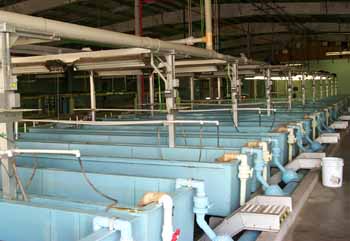Texas has a lot of reservoirs and a lot of fishermen and women. The state’s five fish hatcheries help make the chance for a good day of fishing better.
At the A.E. Wood Fish Hatchery, manager Mike Matthews said in a normal year, the hatchery puts out 3 to 6 million fingerlings that are stocked into up to 300 reservoirs.
“We’re the only place that does channel catfish fry, up to 1 to 2 million per year,” Matthews said. “And we produce 1 to 2 million hybrid striped bass and 1 to 2 million Lone Star bass.”
This year, production is down at the hatchery in San Marcos while pond liners are being replaced.
Matthews said the purpose of stocking is more involved than helping a lake’s numbers of fish increase — especially with largemouth bass and Guadalupe bass.
“We usually stock fingerlings approach- ing 2 inches long,” he said. “The fingerlings that make it grow up and reproduce, that’s been shown. We’re not necessarily trying to impact the overall population, we’re trying to get the right bass to make it and reproduce.”
The process with bass has worked and has been witnessed by anglers and researchers. “The impact goes far beyond what happens in that first year — it translates to a large number of fish and can change the overall look of a lake,” Matthews said. Five hatcheries in Texas produce more than 7.5 million bass, 1.2 million catfish, 5.8 million striped bass and hybrid striped bass, and 1 million other species of fish for stocking into Texas reservoirs each year, ac- cording to Texas Parks and Wildlife Department.

A. E. Wood Fish Hatchery, San Marcos
A. E. Wood Fish Hatchery is located along the banks of the San Marcos River and specializes in rearing fingerling sport- fish for stocking into more than 300 Texas reservoirs. Built in 1949, it was named for A. E. Wood who served on the Texas Game & Oyster Commission, a forerunner of the Texas Parks & Wildlife Department. The hatchery produces Lone Star largemouth bass, channel catfish, rainbow trout, and koi carp (raised as forage for brood fish).

Dundee State Fish Hatchery, Electra
The Dundee State Fish Hatchery, located west of Wichita Falls, was built in 1927. It is currently the largest Texas state hatchery in operation, with 97 ponds providing 83 sur- face acres. Approximately 7 million striped bass fry and 7 million hybrid striped bass fry hatch each year at the facility, which also produces channel catfish, rainbow trout and koi carp.
In 2012, fish rearing operations were suspended due to dry conditions at Lake Kemp. Operations resumed after 2016, but production has been limited.
John D. Parker East Texas Fish Hatchery, Brookeland
The newest freshwater hatchery came on line in 2012, producing up to 5 million fingerlings each year. The new facility replaced the 1932 Jasper Fish Hatchery and provides production capacity for largemouth bass, catfish, sunfish and forage fishes.
The hatchery is named for the late John D. Parker of Lufkin, who served as a Texas Parks and Wildlife commissioner from 2003-2009 and was instrumental in securing funding for the project. The hatchery produces Florida largemouth bass, channel catfish, blue catfish and sunfish.
Possum Kingdom Fish Hatchery, Graford
The Possum Kingdom hatchery occupies 103 acres of land originally purchased by the State of Texas in 1947 for $12,858. The first phase of building was completed in 1950 at a cost of $297,000. In 2000, extensive renovations were implemented.
The hatchery produces striped bass, hybrid striped bass, channel catfish, smallmouth bass, rainbow trout, walleye, saugeye, and koi carp.
Texas Freshwater Fisheries Center, Athens
Largemouth bass production is the focus of the TFFC hatchery, which produces 3 to 4 million Florida largemouth bass fingerlings annually. Another function is the production of food for bass. In excess of 70 million koi carp (goldfish) are produced annually for this purpose.
Water for the TFFC hatchery and exhibits is pumped from Lake Athens, filtered, and treated with ozone. After being used, the water is returned to the lake. The hatchery includes the Lunker Bunker, visible through a bay window at the end of the hatchery gallery in the Visitor Center. Tanks are used to hold largemouth bass entered into the ShareLunker Program. These tanks can also be used as quarantine or treatment areas for new or sick fish.
Photo from Texas Freshwater Fisheries Center


